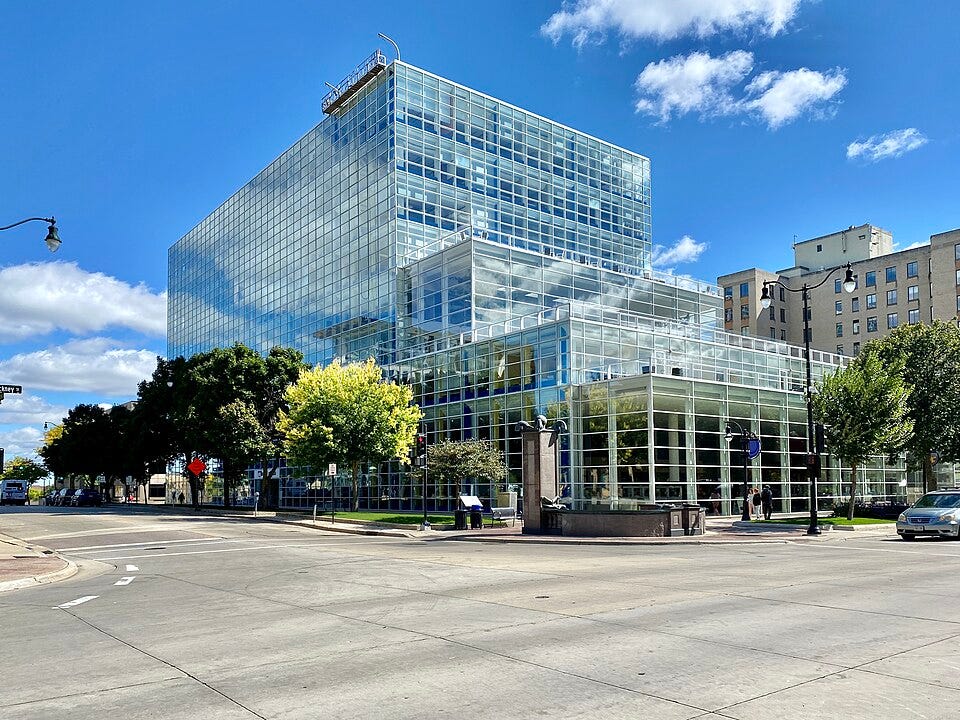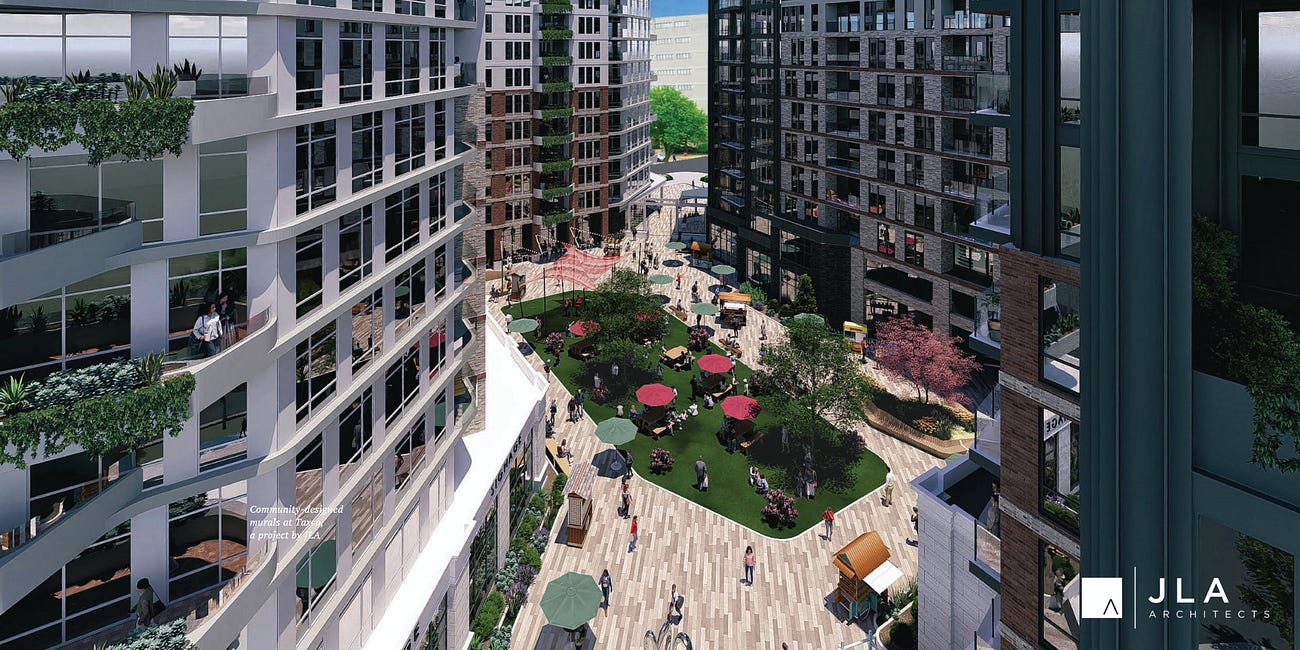Can Madison "see the cat"?
When prices keep rising, it's important to take stock and incentivize building. That starts with valuing land correctly with a land value tax.

I've lived in Madison for 8 years now, arriving to the City in August of 2017. In that time I've walked, biked, and driven through neighborhoods, observing how people, buildings, and infrastructure interact. I’ve seen things that make me happy: families walking with strollers, bikers passing counters incrementing to the thousands digit, (night/farmer’s) markets filling streets to capacity. I've seen things that make me sad: kids crossing streets on the median as cars rush by, bus stops with portable chairs because they lack a bench, street pole memorials recognizing tragedy. And I've seen vacant lots that make me question how we are simultaneously in a housing shortage yet cannot build on underused land.
Let's talk about 33 W Johnson Street.
Have you walked near the Capitol on West Johnson and wondered “what is an abandoned building doing in the middle of Downtown?” That building near State Street Comedy or the Dayton/Pinckney Parking Garage? It was formerly a high school and it is currently owned by Madison Area Technical College (MATC).
What's surprising to me is after all the nearby development, in particular student housing, this lot remains dilapidated. Not that it hasn't tried to glow-up! There's been multiple development attempts, including one in the last year, but nothing seems to stick.
Why can't we develop a building people will use? And what should we build on the lot? It all comes down to land value, how we (don't) tax it, and the consequences of failing to realize its value.
What makes land valuable?
Over a century ago, Henry George wrote Progress and Poverty1 that hypothesized why people could remain poor even as technology improved and cities grew wealthy. He came to the conclusion that people built value through businesses, services, and education physically located on land in specific areas. As these value-generating entities agglomerated, people valued them more and wanted to locate near them, which allowed the owners of the land beneath the entities to demand higher rent. He postulated that the increases in land rent exceeded the increases in wealth that could be generated by the entities, which caused the people working the businesses to make less income and simultaneously generate business cycles that could quickly turn into depressions.
To get around this issue of land rent and speculation, his solution was to tax the value of the land. Land is the limited resource in cities and it would be efficient to avoid taxing the businesses, buildings, and services that cities need to thrive. Instead, focus on the thing that is nothing but a physical location. Land owners don't provide any value except the idea of what could be built on the land. They shouldn't be rewarded for purchasing preconceptual ideas of what makes a city years before they come to fruition; we should reward those who build the City into a desirable place to be.
This is the basis of a land value tax (LVT). As the entities built on the land generate more value for a City, the City taxes the underlying land at it’s value. That value is generated by being located near those entities, and crucially it allows any excess value on a parcel by parcel basis to be retained by the entities. It doesn't allow the land owners to “freeride” on owning a valuable location that is in limited supply, cannot be generated further, was granted through a process of “finders keepers”, and whose value is entirely determined by the entities built around it. In simpler terms: “use it or lose it, because it wasn't really yours to benefit from anyway.”
How do we have a vacant lot in the middle of the City?
Madison generates 70% of its revenue through property taxes. Each property on a lot is assessed annually to have a value based on what's built on the lot (known as the “improvements” value). For many older, 100+ year old buildings on the Isthmus (where Madisonians first settled), these physical buildings cannot match the assessed value that is typically dictated by market forces. There are homes selling for close to $1 million that probably do not have a single right angle remaining. I know we have some prolific preservationists, but not every 19th century home on Jenifer St is in incredible shape. The reason why these homes sell for more than what the physical home is worth is because the location (aka land) is valuable.
The Madison Assessor is able to assign land value for lots when property value cannot conceivably match what is physically built. Land and property are then combined into a single value that is taxed equally across the City. This allows Madison to maintain a uniformity clause required by the State and assessed values are audited to ensure fairness.
Because we rely on property values first, and add land when the property value doesn't match what it could fetch on the market, we can get funky numbers. In the case of 33 W Johnson, the building is derelict and requires a tear down; it is worth $0. But the City would be in violation of state law if it said it was worth $0, so the land is currently valued at $1,000,000 (generating over $17,000 in taxes).
But let's be serious. This is an 88,000 sq ft lot a block from the Capitol. The average home in Madison sells for $430,000. If I were legally allowed to buy that land at the City’s assessed value, I would round up a dozen friends and purchase it immediately. And then sell it. For something closer to 8 digits.
I know it's on the Capitol Square, but consider the US Bank Plaza at 1 S Pinckney Street.

This is a similarly sized 87,000 sq ft building with multiple businesses and condos. These entities collectively are assessed at nearly $70,000,000 and generate over $1,200,000 in taxes. When the taxes on this building alone exceed a piece of land that's the same size and less than a 2 minute walk away, we have a problem!
What does this discount mean for the City? Failed project after failed project because the land owner isn’t incentivized to sell unless the deal is really good. After all, this could host over $50,000,000 in property value! Might as well hold on until someone meets a higher price, and if they don't this year, well that's just another $17,000 to pay to hold on to the land. We can wait centuries to sell and still make a profit.
In addition to this, because the land owner is a higher education college in a landscape where all institutions are looking for new revenue paths, they are incentivized to maximize the revenue on this project2. If Madison becomes a bit bigger, and that land becomes worth more than $100,000,000, why not hold on to it? All it has to do is speculatively gain more than $17,000 in value each year, even if it just sits there.
If we taxed this at the value of the land, MATC would be incentivized to either build something useful or sell the land to someone who could3. That would potentially be more campus, more housing, or more business; all services that would help the neighbors and Madisonians across the City. And with the City receiving proper revenue, there would be less of a constraint on the budget.
How many 33 W Johnson's are there?
There is a data set that drives the information available on City of Madison Assesor's Office - Property Look-up that anyone can download. This lists many known characteristics of lots in Madison like lot width, year built, central A/C, etc. For our purposes, I looked at all 82,111 lots and found the number of parcels with over 50,000 sq ft and generate less than $20,000 in annual taxes.
There are 878 parcels that fit these criteria.
It’s entirely possible that most of these parcels are paying a fair amount. Many of these are likely on the outskirts of the City and there isn’t much developed that would make this land valuable.
HOWEVER, in the “PropertyUse” column, there are 3,190 parcels in our dataset that have the description of “vacant”. About 4% of the parcels in Madison are not currently being used. This search doesn’t include 33 W Johnson, which is considered a “school” in the database. How many properties are listed with a use but aren’t currently generating value? Or how many parcels are generating significantly less revenue than what would be generated if there was a clean slate? For example, consider E Washington and the mixed-use apartment buildings Lyric and Arden (1010 and 1050 E Washington Ave):
And compare that to an equally sized lot (within 1,500 sq ft) across the street featuring a car wash, a manufacturing firm, office space, a warehouse, and some apartments:
These lots are eight lanes and a median across from each other and yet there is a $1,400,000 tax difference (over 1,000%). They take up about the same amount of space, and while the neighborhoods aren’t exactly the same (the even numbered block is next to an elementary school, a soccer stadium, and small multifamily housing compared to hotels, the Madison Metro Bus depot, and additional commercial spaces for the odd numbered lot), it doesn’t warrant a $1 million difference.
Will every lot like this immediately be worth $1,000,000 in additional tax revenue if we move to a land value tax? No. “No free lunch” or something like that. If anything, the even lot will likely see a reduction in taxes because so many parcels are undervalued. If we reassessed parcels based on land value and used the existing assessment baseline of $48,989,000,000 in total real estate value, under-performing parcels would see tax hikes and over-performing parcels see tax reductions.
Does performance matter?
I can anticipate skeptics getting very frustrated right now. “Define performance. Are you saying that the mom & pop restaurant that’s been a Madison staple for 80 years has to close because the new taxes are too high? Or we can't allow car washes in the city?That’s rude and I won’t stand for it”. Or something like this.
And the beauty of the tax is that it doesn’t rely on maintaining high performance for all properties. There are really just some parcels that need to start paying their share for the amount of space they take. Some examples of under-performers:
Surface parking lots on the Isthmus
Warehouses on the Isthmus
Lake houses (especially those with large lots)
Excessively large lot single family homes in desirable neighborhoods
Malls or box stores
Drive-thrus
Vacant buildings
The types of buildings that over-perform and I anticipate would see a tax reduction are:
Small storefronts that efficiently use space
Homes on small or medium lots
Multifamily homes
Large apartment buildings that are close to the Capitol view limit
I personally want to see us build more of the over-performers and I think most people would agree.4 Anyone that sees a piece of land that can contain these entities and can produce value greater than the tax of the land would be incentivized to build it immediately. By taxing the land, and not the entity, any excess profit is at the discretion of the entity owner and not the land owner.
The list of under-performers is also a list that most people don’t want to be building more of and some people want to reduce our current inventory. At the very least, if you want to have an entity on this list on your land, you are going to pay the luxury of it’s under-performing nature. And that’s fine. If you want to pay extra for a house on Mendota/Monona, by all means please do. But you should pay a premium for that coveted land you are building a private property on (that only you can access).
The cats are alive in Madison
To bring this all back to the top, I hope I at least have you considering why it’s important to properly assess and tax land rather than property. There are vacant and underused buildings on expensive land and the current land owners aren’t incentivized to fix it. Instead, they speculate on future rental profits and pay nothing in comparison to hold on to the land. By taxing the land and allowing people to build entities of value, we will see further expansion of value generating entities and the end of underused parcels. This is a consequential change. We would see assessments change by the millions in some parts of the City that accurately reflect what that land means to all of us. I expect there to be push back, especially by those who currently benefit from undervalued land that allows them to pay less in taxes. That isn’t a reason to not make this change. What I hope for is that you do “see the cat” and can help bring about this change with me.
More from Counting Cranes
Getting to a Land Value Tax in Wisconsin
I previously wrote about my desire to implement a land value tax (LVT) in Madison. I discussed several vacant or underused lots near Downtown that I think would see rapid development if they were appropriately assessed and taxed.
Consensus, Rent, and "Affordable Housing"
Last month I wrote about the Housing Forward proposals put forward by Mayor Rhodes-Conway and many alders.
This book was only out sold by the Bible in the 1890’s for English language books. Incredible.
See Breaking the Gridlock for more info on the financial stability of the project, including MATC’s explanation that “the leasing finance structure provides additional operating revenue that supports the annual operational expenses of the college”
Leasing is nice for MATC (they have a property consistently generating revenue, they retain ownership of the land), but bad for the City because MATC is better off speculating for greater rent opportunities than building
Maybe not the large apartment buildings, but plug your nose and think of the tax revenue!





